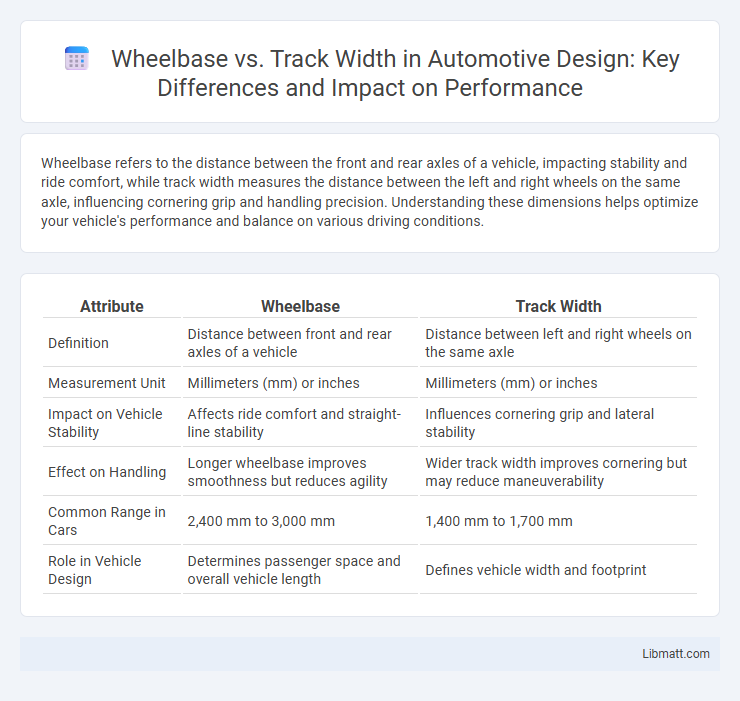Wheelbase refers to the distance between the front and rear axles of a vehicle, impacting stability and ride comfort, while track width measures the distance between the left and right wheels on the same axle, influencing cornering grip and handling precision. Understanding these dimensions helps optimize your vehicle's performance and balance on various driving conditions.
Table of Comparison
| Attribute | Wheelbase | Track Width |
|---|---|---|
| Definition | Distance between front and rear axles of a vehicle | Distance between left and right wheels on the same axle |
| Measurement Unit | Millimeters (mm) or inches | Millimeters (mm) or inches |
| Impact on Vehicle Stability | Affects ride comfort and straight-line stability | Influences cornering grip and lateral stability |
| Effect on Handling | Longer wheelbase improves smoothness but reduces agility | Wider track width improves cornering but may reduce maneuverability |
| Common Range in Cars | 2,400 mm to 3,000 mm | 1,400 mm to 1,700 mm |
| Role in Vehicle Design | Determines passenger space and overall vehicle length | Defines vehicle width and footprint |
Introduction to Wheelbase and Track Width
Wheelbase, the distance between the front and rear axles of a vehicle, directly influences stability, ride quality, and handling characteristics. Track width, referring to the distance between the left and right wheels on the same axle, impacts cornering grip and overall balance. Understanding your vehicle's wheelbase and track width helps optimize performance and safety.
Understanding Wheelbase: Definition and Importance
Wheelbase refers to the distance between the front and rear axles of a vehicle, playing a crucial role in determining ride quality and stability. A longer wheelbase generally enhances straight-line stability and cabin space, whereas a shorter wheelbase improves maneuverability and handling responsiveness. Understanding wheelbase dynamics is essential for vehicle design, affecting acceleration, braking efficiency, and overall driving comfort.
Defining Track Width: Key Concepts
Track width refers to the distance between the centerlines of two wheels on the same axle, measured from left to right. This measurement is crucial for vehicle stability, influencing cornering performance and overall handling dynamics. A wider track width generally enhances lateral stability by lowering the vehicle's center of gravity and reducing body roll during turns.
How Wheelbase Affects Vehicle Stability
A longer wheelbase enhances vehicle stability by distributing weight more evenly and improving straight-line tracking, reducing the likelihood of fishtailing at high speeds. Increased wheelbase length also helps absorb road irregularities, providing a smoother, more controlled ride during cornering. However, while a longer wheelbase stabilizes the vehicle, it may reduce maneuverability in tight turns compared to a shorter wheelbase with a wider track width.
The Impact of Track Width on Handling
Track width significantly influences your vehicle's handling by enhancing lateral stability during cornering, reducing body roll, and improving grip. A wider track width lowers the center of gravity effect and distributes weight more evenly across the tires, allowing for more precise steering response and better road contact. Adjusting track width can optimize handling characteristics for various driving conditions, directly impacting performance and safety.
Comparing Wheelbase and Track Width: Key Differences
Wheelbase measures the distance between the front and rear axles, significantly impacting vehicle stability and ride comfort, while track width refers to the distance between wheels on the same axle, influencing cornering ability and lateral grip. A longer wheelbase generally provides a smoother ride, whereas a wider track width enhances handling and reduces body roll during turns. Understanding these key differences helps you optimize vehicle dynamics for performance or comfort based on your driving needs.
Influence on Ride Comfort and Performance
A longer wheelbase typically enhances ride comfort by providing greater stability and smoother handling over uneven surfaces, while a wider track width improves cornering grip and lateral stability, boosting overall performance. The wheelbase influences the vehicle's ability to absorb road irregularities, reducing pitch and enhancing ride quality, whereas track width affects the distribution of lateral forces during turns, contributing to better traction and control. Balancing wheelbase and track width is essential for optimizing both comfort and dynamic driving characteristics.
Wheelbase vs Track Width in Different Vehicle Types
Wheelbase and track width significantly influence vehicle stability and handling across various types. In sedans and sports cars, longer wheelbases enhance ride comfort and high-speed stability, while wider track widths improve cornering grip and lateral stability. Off-road vehicles feature shorter wheelbases for better maneuverability on rough terrain, combined with wider track widths to increase balance and prevent tipping.
Choosing the Right Dimensions for Your Needs
Wheelbase and track width significantly impact vehicle stability, handling, and ride comfort, making it essential to choose dimensions that align with your driving conditions and preferences. A longer wheelbase generally improves straight-line stability and ride smoothness, while a wider track width enhances cornering grip and reduces body roll. Evaluating your primary use, whether for daily commuting, off-road adventures, or performance driving, helps determine the optimal combination of wheelbase and track width for your vehicle.
Conclusion: Optimizing Wheelbase and Track Width
Optimizing wheelbase and track width enhances vehicle stability, handling, and ride comfort by balancing weight distribution and cornering capabilities. Your vehicle's wheelbase length influences ride smoothness and directional stability, while track width affects lateral grip and roll resistance. Properly tuned dimensions improve safety and performance tailored to specific driving conditions and vehicle types.
Wheelbase vs Track width Infographic

 libmatt.com
libmatt.com